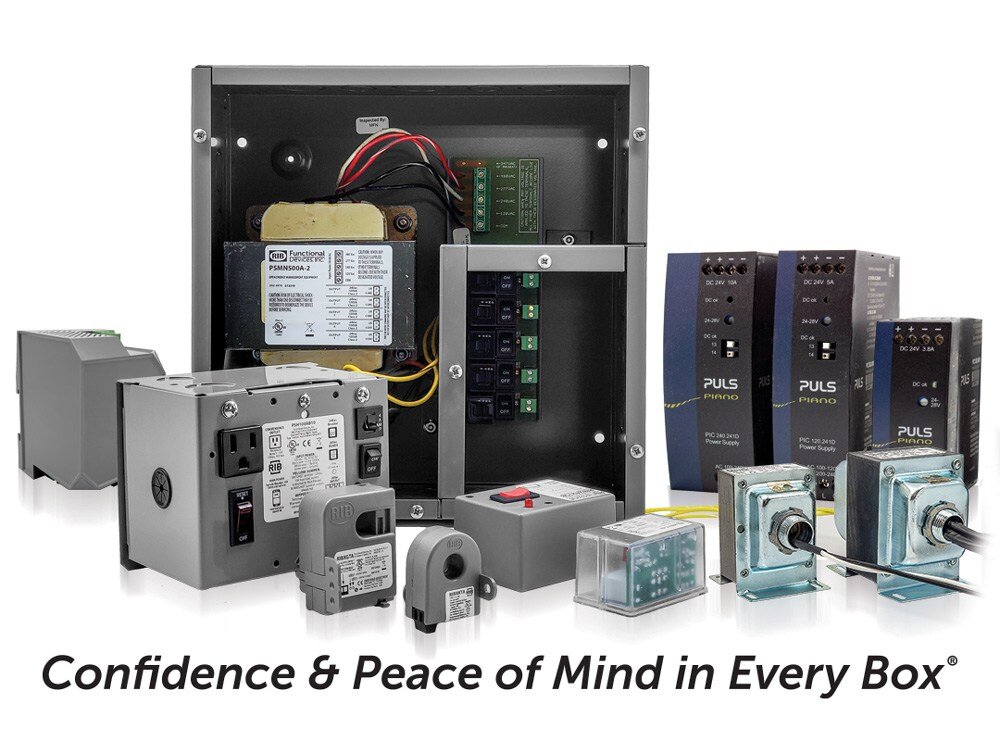We live in a globally interconnected reality. Businesses depend on global supply chains. People work remotely. We’re always a few clicks away from reading up on current international events.
The different systems running your commercial building are also connected — a mini-world of its own. With smart buildings, enhanced security systems, and complex building management systems (BMS), system isolation is a thing of the past. So, what’s helping your building’s different controls talk to each other? Industrial peripheral devices!
In a commercial building, you need industrial-grade peripheral devices to expand the functionality of your building and lighting systems, enabling better efficiency, reliability, and capability. Let’s highlight the benefits and value of these little wonders.
At Functional Devices, we make components for all sorts of applications. For example, our UL508 and NEMA4 lines of enclosed relays, power supplies, and enclosures work well for industrial building and lighting systems. Contact us to learn more about which products make sense for your building!
What Are Industrial Peripheral Devices?
A peripheral device is what it sounds like — a component on the periphery of the BMS. These additional devices are not part of the core functioning of your building’s systems. Instead, they expand what the BMS is capable of by providing data input or control output beyond what the BMS can do independently. Expanded capability translates into more detailed monitoring and precise control of specific, interconnected building actions.
Examples of peripheral devices include:
- Sensors
- Controllers
- Actuators
- Gateways
- Displays
But what’s the big deal about industrial-grade devices? Here are some key differences you can expect to see in industrial-rated vs. commercial-rated peripheral devices:
- High load capacity
- High accuracy and precision
- Wide operating ranges
- Fast response times
- Enhanced safety and energy efficiency features
- Environmental certification and compliance
- Sophisticated control interface and remote management capabilities
- Robust construction and protection from environmental hazards (high IP rating)
- Continuous operation capabilities and extended lifespan
As you can see, industrial-grade devices can withstand the demands of a commercial setting. Now, let’s explore what peripheral devices can do and their benefits.
Importance of Peripheral Devices in Building and Lighting Systems
Generally, peripheral devices enhance the durability, performance, and scalability of your BMS. Here are some more specific examples of what these components can achieve:
- Optimized system efficiency. Peripheral devices like sensors and controllers can enhance building automation systems (BAS).
- Improved energy management. Better efficiency leads to reduced energy waste and costs.
- Smart functionality. Peripheral devices allow integration of Internet-of-Things (IoT) devices with the BMS.
- Enhanced safety and compliance. Peripheral devices allow for refined monitoring systems that detect faults and ensure regulation adherence.
Peripheral devices transform isolated buildings and lighting systems into a thriving ecosystem for your building.

We’ve highlighted some differences between industrial- and consumer-rated peripheral devices and some of their advantages. Now, let’s see how those unique features translate into benefits for your BMS.
- Reliability in challenging environments. Industrial devices are designed to keep working through temperature fluctuations, humidity, and dust.
- Reduced downtime. Industrial devices are designed for long-term use with minimal maintenance and production interruption.
- Scalability and customization. These devices allow your BMS to adapt to evolving system needs and technologies, growing as you grow to accommodate more system requirements.
- Cost-effectiveness over time. With their rugged dependability, industrial devices have reduced repair and replacement costs compared to consumer-grade devices.
If you’re working in a commercial environment, consumer-grade products, peripheral devices, or anything else don’t make sense. You need an industrial upgrade.
Applications in Building and Lighting Systems
Sensors, actuators, controllers, oh my! Here are those illustrations we promised of how peripheral devices might work within your BMS.
- Dimming, motion detection, and daylight harvesting in a smart lighting system
- Managing temperature and air quality efficiently in an HVAC climate control system
- Integrating surveillance cameras, door controls, and alarms in a security system
- Tracking consumption and generating actionable insights for enhanced energy monitoring and reporting
Imagine one building system communicating with another or performing beyond its core functions. In that case, you’ve probably considered an application for a peripheral device!
Your Partner for Industrial Peripheral Devices & Relays
With their many benefits and ability to withstand commercial demands, industrial-grade peripheral devices are a must for your facility's building and lighting systems. Investing in high-quality relays and other components gives you long-term gains, like reduced maintenance and costs, increased efficiency and reliability, and unparalleled customization options.
We suggest evaluating your current BMS and considering whether it’s time for an upgrade. The skilled engineers at Functional Devices would love to chat about which peripheral devices make sense for your systems. Our innovative Relay in a Box comes prepackaged to save you even more time, effort, and cost. Contact us today to learn more about our industrial-grade peripheral devices!
About Functional Devices, Inc.

Functional Devices, Inc., located in the United States of America, has been designing and manufacturing quality electronic devices since 1969. Our mission is to enhance lives in buildings and beyond. We do so by designing and manufacturing reliable, high-quality products for the building automation industry. Our suite of product offerings include RIB relays, current sensors, power controls, power supplies, transformers, lighting controls, and more.
We test 100% of our products, which leads to less than 1 out of every 16,000 products experiencing a failure in the field.
Simply put, we provide users of our various products confidence and peace of mind in every box.